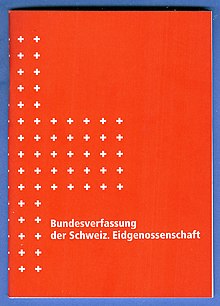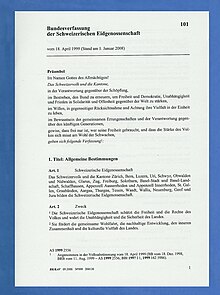Federal Constitution of the Swiss Confederation
| Basic data | |
|---|---|
| Title: | Federal Constitution of the Swiss Confederation |
| Short title: | federal Constitution |
| Abbreviation: | BV |
| Type: | Constitution |
| Scope: | Swiss Confederation |
| Legal matter: | Constitutional law |
|
Systematic legal collection (SR) : |
101 |
| Original version from: | April 18, 1999 |
| Entry into force on: | January 1, 2000 |
| Please note the note on the applicable legal version. | |
The Federal Constitution of the Swiss Confederation ( French Constitution fédérale de la Confédération suisse , Italian Costituzione federale della Confederazione Svizzera , Romansh ) of April 18, 1999 (abbreviated BV , SR 101) is the constitution of Switzerland . It goes back to the first federal constitution of 12 September 1848 with the Switzerland from the confederation for the state was united.
Position in the legal hierarchy
The federal constitution is at the top level of the Swiss legal system. All federal ordinances and decrees as well as the constitutions, laws, ordinances and decrees of the cantons and communes are subordinate to it. In principle, these must therefore not contradict the Federal Constitution.
The Federal Constitution, however, excludes the direct (abstract) judicial contestation of "acts" (i.e. legislative provisions and individual acts) of the Federal Assembly and the Federal Council ( Art. 189 ). However, the constitutionality of an ordinance of the Federal Council or the Federal Assembly by the Federal Court is possible in specific cases of application, unless its content is covered by the non-contestable delegation provision in the law. Federal laws and international law are authoritative for the Federal Supreme Court and the other authorities that apply the law ( Art. 190 ), i. H. It is not possible to appeal against their application in court. There is therefore no constitutional jurisdiction for federal laws. This special regulation is an expression of the greater weighting of the principle of democracy compared to the rule of law : the laws passed by the parliament - and possibly adopted by the electorate in a referendum - should not be able to be overridden by a court.
Structure and content
The constitution begins with the preamble , which begins with the reference to God «In the name of God Almighty!» begins. The actual constitutional text is divided into six titles: Title 1 contains general provisions, such as the purpose of the state ( Article 2 ), the position of the cantons ( Article 3 ), the national languages ( Article 4 ) and the principles of the rule of law ( Art. 5 ). Title 2 describes the fundamental rights ( Art. 7–36 ), civil rights ( Art. 37–40 ) and the social goals ( Art. 41 ).
Title 3 is called “Confederation, Cantons and Communes ” and in Articles 43–135 regulates the division of competencies between the three levels of government. The comprehensive list of federal competencies ( Art. 54–125 ) is particularly important: every federal decree must be based on such a norm. If there is no explicit federal competence in a certain area, the cantons are responsible for this and the federal government is not authorized to legislate (see federalism in Switzerland , subsidiarity ). The competencies of the federal government have been continuously expanded over time, and even today this list is subject to relatively frequent changes - be it through the initiation of the federal authorities by means of a mandatory referendum or through popular initiatives .
The fourth title is entitled “People and Estates” and in Art. 136 regulates the political rights of the people and the cantons, in particular the direct democratic rights of the people (initiative and referendum). Title 5 is dedicated to the federal authorities and outlines the organization and competencies of the Federal Assembly ( legislative , Art. 143-173 ), the Federal Council and the federal administration ( executive , Art. 174-187 ) as well as the Federal Supreme Court and the other judicial authorities ( judiciary , Art 188–191 and Art. 191a – c ). The sixth and final title contains the options for revising the constitution ( Art. 192–195 , see below) and the transitional provisions ( Art. 196 and Art. 197 ).
history
Federal Revision Commission of 1848
The Diet decided on August 16, 1847 to set up a commission to revise the federal treaty. On February 17, 1848, the constitution makers from 1848 met for their first meeting in the town hall for the Äusseren Stand Bern. The majority were canton leaders and members of cantonal governments. Six of the twenty-three commission members were elected to the very first Federal Council in the new state . The Federal Revision Commission of 1848 was chaired by Ulrich Ochsenbein from Bern . The work of the commission took 31 meetings in 51 days and ended on April 8 with the presentation of a draft constitution. This was then submitted to the cantonal authorities and the daily statutes, where only a few retouches were made.
Federal Constitution of 1848
The basis for today's federal constitution is the constitution of autumn 12th 1848 (September 12th 1848), when Switzerland was united by the confederation of states to become a federal state . This constitution was signed on the 14th autumn month of 1848 by the last President of the Diet, Alexander Ludwig Funk, and the Chancellor of the Confederation, Johann Ulrich Schiess . The introduction of the constitution of 1848 was preceded by brief armed conflicts ( Sonderbund war ).
The constitution of 1848 was adopted by the Swiss people (only men) in cantonal votes in July and August 1848 with 145,584 votes in favor (72.8%) against 54,320 votes against (27.2%). Yes, they voted: ZH, BE, LU, GL, FR, SO, BS, BL, SH, AR, SG, GR, AG, TG, VD, NE, GE. No: UR, SZ, OW, NW, ZG, AI, TI, VS.
The new constitution was influenced by the United States constitution (the bicameral parliament is modeled on the American House of Representatives and Senate) and the ideas of the French Revolution (civil rights). It stipulated that the cantons would be independent (sovereign), unless they explicitly restrict this sovereignty . At that time, the competence of the federal government was strictly limited and essentially comprised foreign policy, the coin rack, the determination of dimensions and weights, and the establishment or support of public works.
Revision from 1866
The constitution of 1848 was partially revised in 1866: Jews were given equality ; on the other hand, the people refused to grant residents (including those of Swiss nationality) cantonal and communal voting rights.
First complete revision from 1874
The first total revision of the constitution came into force in 1874. It provided for an expansion of federal competencies and popular rights. With this total revision, the legal referendum was also introduced at the federal level. Since 1891, the constitution has included the right of initiative to partially revise the federal constitution. As a result, a fraction of those entitled to vote (currently 100,000) can propose the enactment, amendment or repeal of individual provisions of the Federal Constitution and a vote of the people and the cantons (cantons). Partial revisions of the constitution are therefore possible at any time.
Last complete revision from 1999

The last complete revision of the Swiss constitution dates from 1999. The Federal Council called its draft of November 20, 1996 "Nachführung", in the framework of which non-written constitutional law (created within the framework of the highest court rulings by the Federal Supreme Court) was codified and not at the constitutional level relevant provisions (e.g. absinthe ban ) have been “downgraded”. The Federal Assembly largely followed this concept of a "follow-up", but also incorporated a number of substantive changes beyond the draft of the Federal Council, in particular in the area of the organization of the federal authorities, where the position of the Federal Assembly vis-à-vis the Federal Council was significantly strengthened. The new federal constitution was approved by the people and the cantons on April 18, 1999 with 59.2% or 12 whole and 2 half of 20 whole and 6 half class votes . It replaced the Federal Constitution of May 29, 1874 (old Federal Constitution, short ABV) and has, among others, nine, until then only in deciding the Federal Court and legal commentary detained fundamental rights acquired. It came into force on January 1, 2000.
Revision options
The federal constitution can be amended at any time. The amendment requires the consent of the majority of the people and the cantons ( cantons ). In terms of content, the possibility of amendment is limited by the fact that the constitution must not violate mandatory international law . The partial revision must also not violate the principle of unity of matter ( Art. 193 and Art. 194 BV). The factual feasibility of the initiative is recognized as an unwritten requirement. In practice, the Federal Assembly has so far denied whether there are further substantive barriers in that the core areas of the fundamental norms of the constitution such as fundamental rights, federalism, democracy and the rule of law are binding, but judged inconsistently by legal doctrine.
A constitutional amendment can be demanded by a resolution of the Federal Assembly or by the people through a popular initiative . The federal constitution of Switzerland is - in contrast to the constitution of the United States , for example - a constitution that is frequently modified.
See also
- Constitutional history of Switzerland
- Federal Treaty (predecessor of the Federal Constitution, 1815–1848)
- Mediation Act (forerunner of the Federal Constitution, 1803-1813)
- Political system of Switzerland
- Fundamental rights (Switzerland)
literature
- Giovanni Biaggini : Basics and main features of state constitutional law: Switzerland . In: Armin von Bogdandy , Pedro Cruz Villalón , Peter M. Huber (eds.): Handbuch Ius Publicum Europaeum (IPE) . CF Müller Verlag, Heidelberg 2007, Vol. I, pp. 565-623.
- René Rhinow : The new constitution in Switzerland . In: The State . Journal for State Theory and Constitutional History, German and European Public Law , 41st Vol., 2002, pp. 575–596.
- Bernhard Ehrenzeller , Philippe Mastronardi, Rainer J. Schweizer, Klaus A. Vallender (eds.): The Swiss Federal Constitution . St. Gallen commentary. 2nd Edition. Dike, Zurich 2008, ISBN 978-3-03751-051-3 .
- Jörg Paul Müller : Fundamental rights in Switzerland. Stämpfli Verlag, Bern 1999, 4th edition 2008, ISBN 978-3-7272-9792-2 .
- Jörg Paul Müller: Realization of the basic rights according to Article 35 of the Federal Constitution. Stämpfli Verlag, Bern 2018, ISBN 978-3-7272-3395-1 .
Web links
- Dossier on the current federal constitution and that of 1848 on the side of the Federal Assembly
- Federal Constitution of the Swiss Confederation of April 18, 1999 - Systematic compilation of Swiss federal law with lists of all popular initiatives and all referenda that have been accepted .
- Historical constitutions of Switzerland 1291–1999
- Andreas Kley: Federal Constitution (BV). In: Historical Lexicon of Switzerland .
- Report on the draft of a federal constitution, dated April 8, 1848 / submitted by the revision commission appointed by the daily statute on August 16, 1847
Individual evidence
- ^ Alfred Escher Foundation: Federal Revision - Alfred Escher Letter Edition. Retrieved October 17, 2017 .
- ↑ Rolf Holenstein: How Switzerland found the Philosopher's Stone in 1848 In: NZZ Geschichte , No. 17, July 2018, page 28
- ↑ Dossier on the Federal Constitution on parlament.ch
- ^ Andreas Kley: Federal Constitution (BV). In: Historical Lexicon of Switzerland .
- ^ Wolf Linder, Christian Bolliger, Yvan Riedle: Handbook of the federal referendums 1848 to 2007 . Haupt Verlag, Bern, 1st edition: 2010, page 19, ISBN 978-3-258-07564-8
- ↑ a b c Dossier on the Federal Constitution on parlament.ch
- ↑ See list of federal referendums





